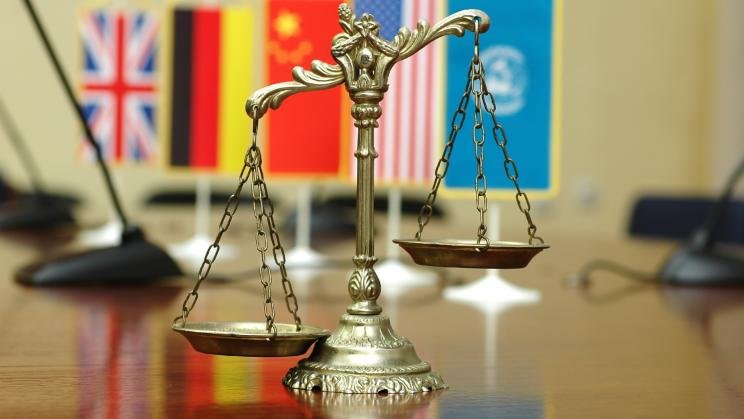What is International Humanitarian Law (IHL)?
IHL is a package of measures to mitigate the impact of armed conflict. It protects people who are not part of combat. Moreover, it limits the sources and methodology of warfare. Basically, IHL enforces three principles i.e., distinction, proportionality, and precautions.
The Principle of Distinction differentiates combatant and non-combatant forces during armed conflict. Besides, the proportionality principle says that military attacks must pursue if the civilian casualties don’t outweigh the military advantages.
Likewise, the Principle of Precaution remarks that extreme measures must be taken before the conduction of military operations. IHL is a part of international law that governs the relations among states.
In this context, it regulates the armed conflict but doesn’t apply to the state’s usage of force. UN Charter decides whether states’ decision of resorting to force goes in line with the rules or not. UN Charter is a distinct but vital part of International law.
Origin of IHL
The origin of IHL goes back to ancient civilizations and religions. While the universal codification of IHL started in the 19th century. In this regard, IHL provides a balance between military requirements and humanity. It regulates situations where the enemy is in the weaker position and there are chances to limit the consequences.
Basic Components of IHL
The vital part of IHL constitutes four Geneva Conventions of 1949. Subsequently, IHL includes Additional Protocols of 1977 and agreements relating to the prohibition of weaponry.
It includes the Convention for the Protection of Cultural Property 1954, Biological Weapons Convention 1972, Conventional Weapons Convention 1980, and, Chemical Weapon Convention 1993.
Likewise, the 1997 Ottawa Convention and Convention on the Rights of the Child 2000 are also part of it. Many conventions are part of customary law which is a kind of general law that bounds every state.
Application of IHL
Along these lines, IHL applies to armed conflict. It doesn’t cover internal tensions within states. In addition to that, the law applies to all the involved parties of conflict regardless of who initiated the conflict.
It also makes distinctions between non-international and international armed conflicts. International armed conflict is about the conflict between at least two states.
Whereas non-international conflicts are limited to a territory of a single state. But, Article 3 of the Geneva Conventions mentions the limited role of IHL in internal conflicts.
IHL, ICL, and Human Rights Law
Furthermore, it is also important to differentiate IHL from Human Rights Law. Human Rights Law belongs to the times of peace but suspends during the armed hostility.
On the other hand, International Criminal Law regulates acts of serious crimes including procedures of investigation, prosecution, and punishment. Most importantly, ICL deals with the case where IHL is violated. Such acts are called war crimes.
What are Jus ad Bellum and Jus in Bello?
Jus ad Bellum refers to the situation of an armed force or when states persuade war. The Charter of UN carries the core elements of Jus ad Bellum.
However, Jus ad Bello refers to the parties of armed conflict. International Humanitarian Law is actually the Jus ad Bello.
IHL and Geneva Conventions
The major part of IHL is composed of the Geneva Conventions. In 1864, the first treaty regarding the military victims was signed in Geneva. Afterward, in 1899, international protections of victims included wounded, sick, and shipwrecked in the Hague.
Lastly, the law of Geneva included Prisoners of War (POWs) in 1929. Consequently, the international community adopted the four Geneva Conventions in 1949.
-
First Convention
The very first Convention deals with the law regarding the care of wounded and sick victims of armed conflict. These victims require care no matter from which side they belong.
-
Second Convention
The second Geneva Convention deals with sick and shipwrecked personnel at sea.
-
Third Convention
The third Convention deals with Prisoners of War. POWs must not face ill-treatment, intimidation, and other acts of violence. Similarly, social media must avoid the exposure of POWs for the entertainment of public curiosity.
-
Fourth Convention
The fourth Convention deals to protect civilians from the impact of armed hostilities. In this regard, armed combatants can’t attack or target civilians.
To protect civilians, combatants must differentiate themselves from civilians by carrying weapons and wearing insignia. In the same vein, armed conflict should avoid harming the civilian infrastructure including hospitals, schools, water, and electricity plants.
Likewise, states can not use illegal weaponry. Illegal weaponry causes heavy civilian casualties and damages the infrastructure. Besides, humanitarian organizations and aid workers can access the areas to save lives.
MPhil Scholar at Centre of South Asian Studies, University of the Punjab, Lahore








